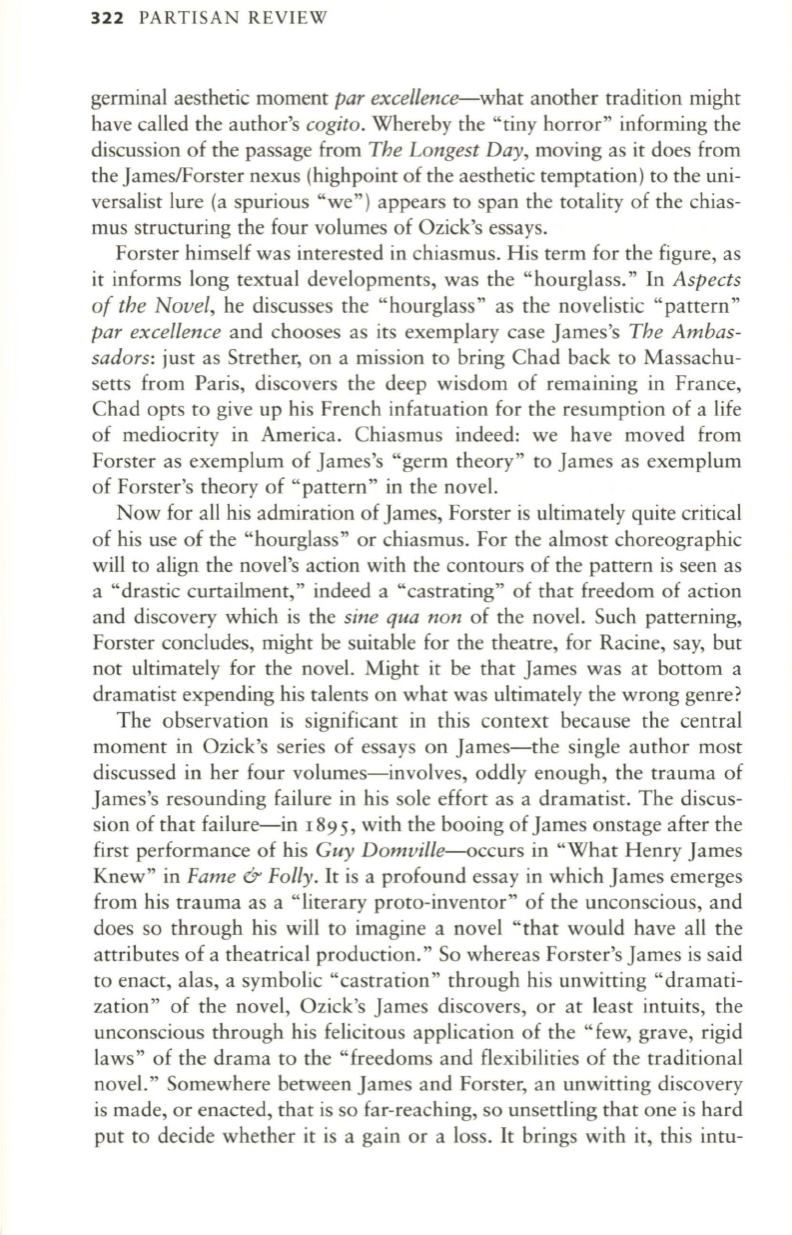
322
PARTISAN REVIEW
germinal aesthetic moment
par excellence-what
another tradition might
have called the author's
cogito.
Whereby the "tiny horror" informing the
discussion of the passage from
The Longest Day,
moving as it does from
the JameslForster nexus (highpoint of the aesthetic temptation) to the uni–
versalist lure (a spurious "we") appears to span the totality of the chias–
mus structuring the four volumes of Ozick's essays.
Forster himself was interested in chiasmus. His term for the figure, as
it informs long textual developments, was the "hourglass." In
Aspects
of the Novel,
he discusses the "hourglass" as the novelistic "pattern"
par excellence
and chooses as its exemplary case James's
The Ambas–
sadors:
just as Strether, on a mission to bring Chad back to Massachu–
setts from Paris, discovers the deep wisdom of remaining in France,
Chad opts to give up his French infatuation for the resumption of a life
of mediocrity in America. Chiasmus indeed : we have moved from
Forster as exemplum of James's "germ theory" to James as exemplum
of Forster's theory of "pattern" in the nove!.
Now for all his admiration of James, Forster is ultimately quite critical
of his use of the "hourglass" or chiasmus. For the almost choreographic
will to align the novel's action with the contours of the pattern is seen as
a "drastic curtailment," indeed a "castrating" of that freedom of action
and discovery which is the
sine qua non
of the nove!. Such patterning,
Forster concludes, might be suitable for the theatre, for Racine, say, but
not ultimately for the novel. Might it be that James was at bottom a
dramatist expending his talents on what was ultimately the wrong genre?
The observation is significant in this context because the central
moment in Ozick's series of essays on James-the single author most
discussed in her four volumes-involves, oddly enough, the trauma of
James's resounding failure in his sole effort as a dramatist. The discus–
sion of that failure-in
1895,
with the booing of James onstage after the
first performance of his
Guy Domville-occurs
in "What Henry James
Knew" in
Fame
&
Folly.
It
is a profound essay in which James emerges
from his trauma as a "literary proto-inventor" of the unconscious, and
does so through his will to imagine a novel "that would have all the
attributes of a theatrical production." So whereas Forster's James is said
to enact, alas, a symbolic "castration" through his unwitting "dramati–
zation" of the novel, Ozick's James discovers, or at least intuits, the
unconscious through his felicitous application of the" few, grave, rigid
laws" of the drama to the "freedoms and flexibilities of the traditional
nove!." Somewhere between James and Forster, an unwitting discovery
is made, or enacted, that is so far-reaching, so unsettling that one is hard
put to decide whether it is a gain or a loss.
It
brings with it, this intu-


